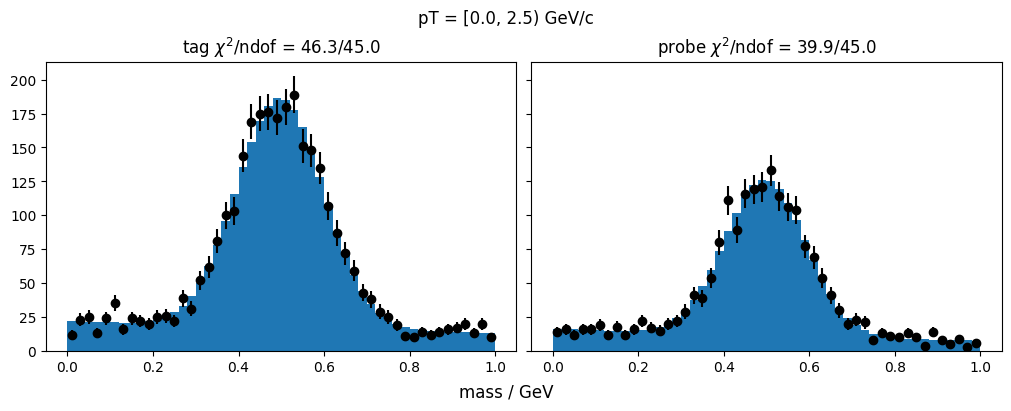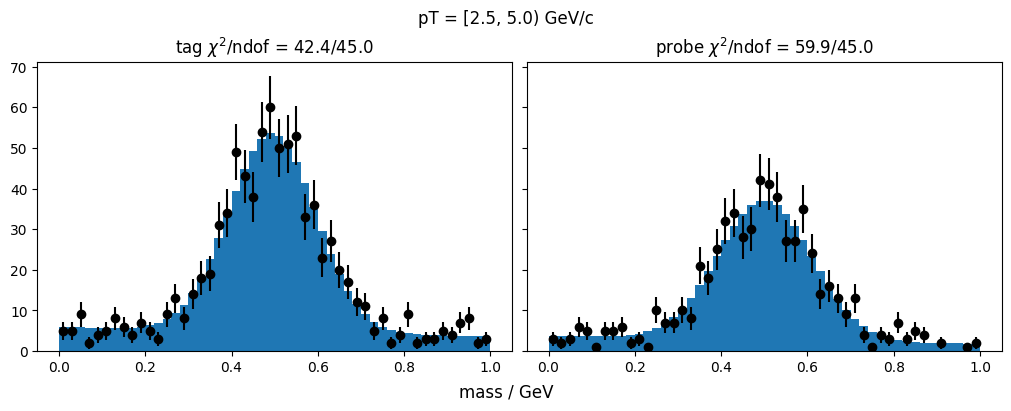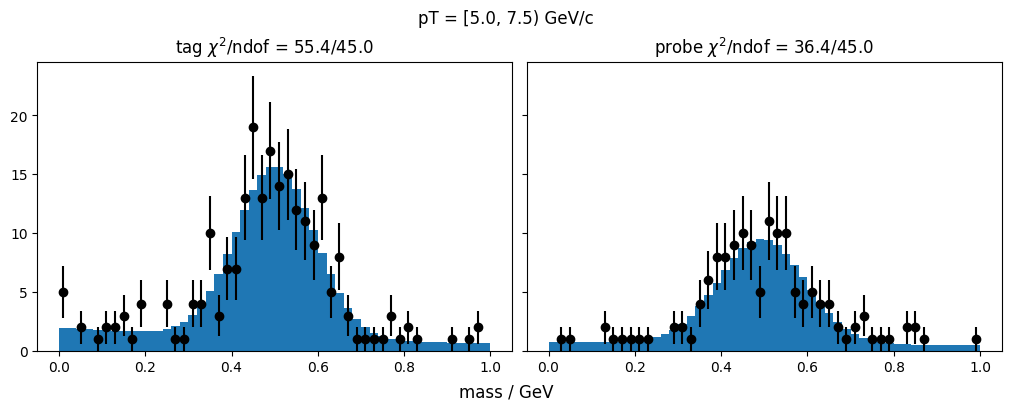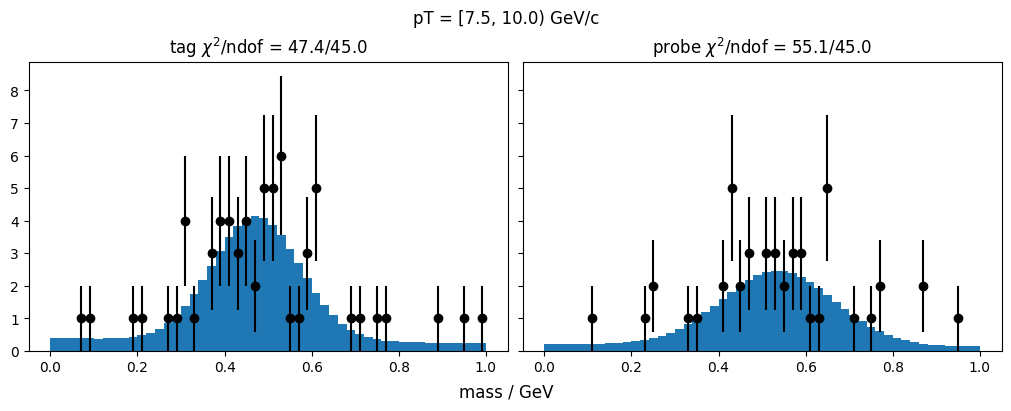Tag-and-probe analysis¶
This is a complex example taken from particle physics how resampling can be used in practice. The actual call into the resample library is very simple, but the setup of the analysis is complex.
A tag-and-probe analysis in particle physics can be used to obtain the selection efficiency for a cut applied to the products of a two-body decay, if the products have the same mass. For example, in the decay \(\phi \to K^+K^-\), we can remove background if we use particle identification information and apply a cut that favors kaons. However, applying the cut will also remove some signal.
The efficiency for such a cut is obtained in the following way. The tag sample is generated by applying the cut only to one of the products. The probe sample is generated by applying the cut on both products. The background is strongly reduced in the probe sample and to a lesser degree in the tag sample.
Under the assumption that the cut efficiency for both products is equal, we can estimate the total number of decays from the signal reduction in the probe sample relative to the tag sample. For that, the peak in the mass distribution of the decay candidates has to be fitted in both the tag and probe samples. Since the probe sample is a subset of the tag sample, it is not independent and computing the statistical uncertainty for the efficiency and the final result is challenging, as there are correlations to consider.
The bootstrap is an elegant solution to this problem.
We generate some toy data in bins of transverse momentum, \(p_T\). The efficiency of the cut on the kaon is 80 %.
[1]:
# boost-histogram, matplotlib, iminuit, numba-stats are external packages
import numpy as np
import boost_histogram as bh
import matplotlib.pyplot as plt
from iminuit import Minuit, cost
from numba_stats import truncnorm, truncexpon
a_pt = bh.axis.Regular(4, 0, 10, metadata="pt")
def fit(pt, mass_axis, val, var, showfig):
mrange = mass_axis.edges[0], mass_axis.edges[-1]
def model(x, ns, mu, sigma, nb, slope):
s = ns * truncnorm.cdf(x, *mrange, mu, sigma)
b = nb * truncexpon.cdf(x, *mrange, 0, slope)
return s + b
if showfig:
fig, ax = plt.subplots(1, 2, figsize=(10, 4), sharex=True, sharey=True, constrained_layout=True)
results = []
for kind in range(2):
mass_val = val[:, kind]
mass_var = var[:, kind]
ntot = np.sum(mass_val)
nll = cost.ExtendedBinnedNLL(
np.column_stack((mass_val, mass_var))
if any(mass_val != mass_var)
else mass_val,
mass_axis.edges,
model,
)
m = Minuit(nll, ns=ntot / 2, mu=0.5, sigma=0.1, nb=ntot / 2, slope=1)
m.strategy = 0 # strategy 0 is sufficient, we don't need to compute the Hessian
m.limits["ns", "nb", "sigma"] = (0, None)
m.limits["mu"] = (0, 1)
m.limits["slope"] = (0, 2)
m.migrad()
results.append(m.values["ns"])
if showfig:
plt.sca(ax[kind])
nll.visualize(m.values)
plt.title(f"{['tag', 'probe'][kind]} $\\chi^2$/ndof = {m.fval:.1f}/{m.ndof}")
if showfig:
fig.suptitle(
f"pT = [{pt[0]}, {pt[1]}) GeV/c"
)
fig.supxlabel("mass / GeV")
return results
def fit_all(histogram, showfig=False):
mass_axis = histogram.axes[1]
val = histogram.values()
var = histogram.variances() # if events are weighted, we also need variances
n_tag = np.empty(val.shape[0])
n_probe = np.empty(val.shape[0])
for i, (vali, vari, pti) in enumerate(zip(val, var, a_pt)):
n_tag[i], n_probe[i] = fit(pti, mass_axis, vali, vari, showfig)
return n_tag, n_probe
def trafo(inputs, showfig=False):
h = bh.Histogram(
a_pt,
bh.axis.Regular(50, 0, 1, metadata="mass"),
bh.axis.Integer(0, 2, metadata="tag|probe"),
)
pt, m, is_probe = inputs.T
h.fill(pt, m, is_probe != 0)
n_tag, n_probe = fit_all(h, showfig)
with np.errstate(invalid="ignore", divide="ignore"):
eps_k = 2 * n_probe / (n_probe + n_tag)
n_rec = (n_tag + n_probe) ** 2 / (4 * n_probe)
return eps_k, n_rec
rng = np.random.default_rng(1)
# generate toy data
pt = rng.exponential(2, size=10000)
s = rng.normal(0.5, 0.1, size=len(pt) // 2)
b = rng.exponential(2, size=len(pt) - len(s))
mass = np.append(s, b)
# true if sample is in tag AND probe sets, false if only in tag set
eps_probe = 0.4
is_probe = rng.uniform(0, 1, size=len(pt)) < eps_probe
expected_eff_k = 2 * eps_probe / (eps_probe + (1 - eps_probe))
The actual bootstrapping is happening in the function variance.
[2]:
from resample.bootstrap import variance
# inputs must have shape (N, K), where N is the dimension in which the algorithm resamples
inputs = np.column_stack((pt, mass, is_probe))
# compute results for original data set
eps_k, n_rec = trafo(inputs, showfig=True)
# compute variance of results with resampled data sets
var_eps_k, var_n_rec = variance(trafo, inputs, size=10)




Plot the results.
[3]:
plt.figure()
plt.xlim(a_pt.edges[0], a_pt.edges[-1])
plt.errorbar(a_pt.centers, eps_k, var_eps_k ** 0.5, fmt="ok")
plt.axhline(expected_eff_k, ls="--", color="0.5")
plt.xlabel("$p_T$ / GeV/c")
plt.ylabel("kaon efficiency");

We recover the correct value within uncertainties.